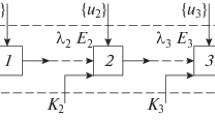Abstract
A systematic approach to the optimal organization of a binary distillation process based on information theory is presented. This approach allows to formulate conditions for optimal function distribution for a complex process, when the feed stream is separated into several product streams. The results of computational experiments based on this approach and known thermodynamic approaches that involve the minimization of exergy losses and entropy production are compared using a numerical example that models the separation process for a methanol–water mixture. The results of computational experiments based on the information-probabilistic approach to the optimal organization of a binary distillation process agree with results obtained by using thermodynamic approaches, evidencing the applicability of the information approach in the context of its integration into the general algorithm of chemical engineering system design based on the information approach.







Similar content being viewed by others
REFERENCES
Kafarov, V.V., Meshalkin, V.P., and Perov, V.L., Matematicheskie osnovy avtomatizirovannogo proektirovaniya khimicheskikh proizvodstv (Mathematical Fundamentals of Computer-Aided Design of Chemical Production Processes), Moscow: Khimiya, 1973.
Podlesnykh, V.I., Teoriya organizatsii (Organization Theory), St. Petersburg: Biznes-pressa, 2003.
Entropiinye metody modelirovaniya v khimicheskoi tekhnike (Entropic Simulation Techniques in Chemical Engineering), Maikov, V.P., Ed., Moscow: Mosk. Inst. Khim. Mashinostr., 1980.
Kafarov, V.V., Metody kibernetiki v khimii i khimicheskoi tekhnologii (Cybernetic Methods in Chemistry and Chemical Engineering), Moscow: Khimiya, 1976, 3rd ed.
Kafarov, V.V., Perov, V.L., Bobrov, D.A., and Naletov, A.Yu., Analysis of chemical engineering processes based on information theory principles, Dokl. Akad. Nauk SSSR, 1977, vol. 232, no. 3, p. 663.
Kafarov, V.V., Perov, V.L., Boborov, D.A., and Naletov, A.Yu., An information criterion for the efficiency of a chemical engineering system, Dokl. Akad. Nauk SSSR, 1977, vol. 236, no. 2, p. 404.
Naletov, V.A., Gordeev, L.S., Glebov, M.B., and Naletov, A.Yu., Information-thermodynamic principle of the organization of chemical engineering systems, Theor. Found. Chem. Eng., 2011, vol. 45, no. 5, p. 631. https://doi.org/10.1134/S0040579511050289
Tsirlin, A.M., Romanova, T.S., and Grigorevskii, I.N., Optimal organization of binary distillation, Theor. Found. Chem. Eng., 2008, vol. 42, no. 4, pp. 421–429. https://doi.org/10.1134/S0040579508040106
Reif, F., Berkeley Physics Course, vol. 5: Statistical Physics, New York: McGraw-Hill, 1967.
Shargut, Ya. and Petela, R., Eksergiya (Exergy), Moscow: Energiya, 1968.
Kondepudi, D. and Prigogine, I., Modern Thermodynamics: From Heat Engines to Dissipative Structures, New York: Wiley, 1998.
Author information
Authors and Affiliations
Corresponding author
Additional information
Translated by E. Glushachenkova
Rights and permissions
About this article
Cite this article
Naletov, V.A., Kolesnikov, V.A., Glebov, M.B. et al. Information-Probabilistic Approach to the Organization of a Binary Distillation Process. Theor Found Chem Eng 53, 410–418 (2019). https://doi.org/10.1134/S004057951902012X
Received:
Revised:
Accepted:
Published:
Issue Date:
DOI: https://doi.org/10.1134/S004057951902012X



